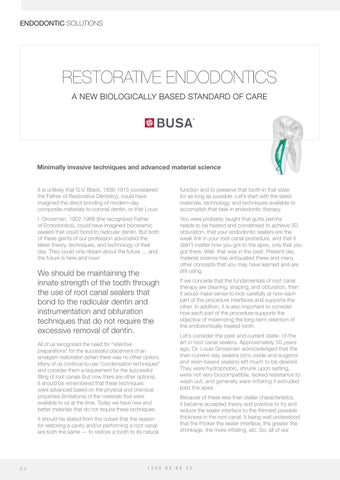ENDODONTIC SOLUTIONS
RESTORATIVE ENDODONTICS A NEW BIOLOGICALLY BASED STANDARD OF CARE
Minimally invasive techniques and advanced material science It is unlikely that G.V. Black, 1836-1915 (considered the Father of Restorative Dentistry), could have imagined the direct bonding of modern-day composite materials to coronal dentin, or that Louis
function and to preserve that tooth in that state for as long as possible. Let’s start with the latest materials, technology, and techniques available to accomplish that task in endodontic therapy.
I. Grossman, 1902-1988 (the recognized Father of Endodontics), could have imagined bioceramic sealers that could bond to radicular dentin. But both of these giants of our profession advocated the latest theory, techniques, and technology of their day. They could only dream about the future … and the future is here and now!
You were probably taught that gutta percha needs to be heated and condensed to achieve 3D obturation, that your endodontic sealers are the weak link in your root canal procedure, and that it didn’t matter how you got to the apex, only that you got there. Well, that was in the past. Present day material science has antiquated these and many other concepts that you may have learned and are still using.
We should be maintaining the innate strength of the tooth through the use of root canal sealers that bond to the radicular dentin and instrumentation and obturation techniques that do not require the excessive removal of dentin.
If we concede that the fundamentals of root canal therapy are cleaning, shaping, and obturation, then it would make sense to look carefully at how each part of the procedure interfaces and supports the other. In addition, it is also important to consider how each part of the procedure supports the objective of maximizing the long-term retention of the endodontically treated tooth. Let’s consider the past and current state- of-the art in root canal sealers. Approximately 50 years ago, Dr. Louis Grossman acknowledged that the then current-day sealers (zinc oxide and eugenol and resin-based sealers) left much to be desired. They were hydrophobic, shrunk upon setting, were not very biocompatible, lacked resistance to wash out, and generally were irritating if extruded past the apex.
All of us recognized the need for “retentive preparations” for the successful placement of an amalgam restoration (when there was no other option). Many of us continue to use “condensation techniques” and consider them a requirement for the successful filling of root canals (but now there are other options). It should be remembered that these techniques were advanced based on the physical and chemical properties (limitations) of the materials that were available to us at the time. Today we have new and better materials that do not require these techniques.
Because of these less than stellar characteristics, it became accepted theory and practice to try and reduce the sealer interface to the thinnest possible thickness in the root canal. It being well understood that the thicker the sealer interface, the greater the shrinkage, the more irritating, etc. So, all of our
It should be stated from the outset that the reason for restoring a cavity and/or performing a root canal are both the same — to restore a tooth to its natural
3 2
1 3 0 0
6 5
8 8
2 2










